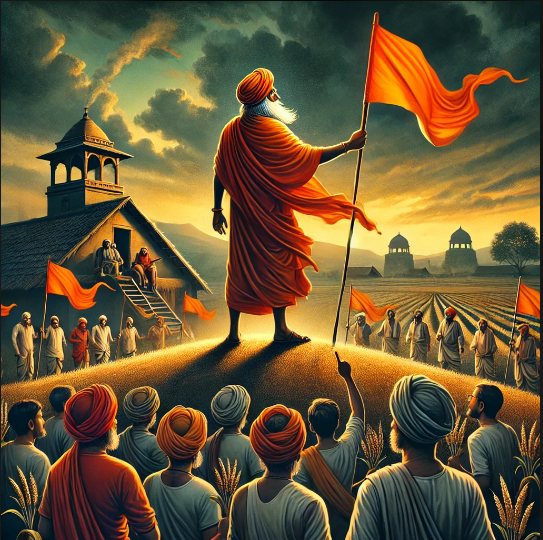Baba Ramchandra, originally named Shridhar Balwant Jodhpurkar, was a prominent figure in India’s peasant movement during the colonial era. He is best known for his role in organizing and mobilizing farmers to fight against the oppressive zamindari system and exploitative landlords in the early 20th century. His efforts laid the foundation for a structured peasant movement in northern India, particularly in the regions of Awadh (modern-day Uttar Pradesh). This essay explores Baba Ramchandra’s achievements as a peasant leader, emphasizing his unique contributions to the socio-economic and political empowerment of the rural masses.
Early Life and Motivation
Baba Ramchandra was born in Maharashtra in the late 19th century. His early life as an indentured laborer in Fiji exposed him to the harsh realities of exploitation, shaping his understanding of systemic oppression. Upon returning to India, he embraced asceticism and traveled across rural areas, eventually settling in Awadh. His deep connection with the peasantry and understanding of their plight motivated him to champion their cause.
Key Achievements as a Peasant Leader
1. Organizing the Peasantry Against Exploitation
Baba Ramchandra played a pivotal role in organizing farmers against the oppressive practices of the zamindars (landlords) and British colonial authorities. The zamindari system subjected peasants to exorbitant rents, forced labor (begar), and arbitrary evictions. Baba Ramchandra traveled extensively across villages in Awadh, raising awareness about these injustices. His ability to connect with the rural masses and articulate their grievances was instrumental in fostering a sense of unity and collective resistance among the peasants.
2. Leadership in the Kisan Sabha Movement
One of Baba Ramchandra’s most significant contributions was his leadership in the Kisan Sabha (Peasant Association) movement. He worked closely with the Awadh Kisan Sabha, founded in 1920, to address issues like high rents, illegal taxes, and forced labor. Under his guidance, the Sabha organized mass protests and strikes, pressuring landlords and colonial authorities to reform their exploitative practices. Baba Ramchandra’s emphasis on non-violent resistance set a precedent for future peasant movements.
3. Mobilizing Religious and Cultural Symbols
Baba Ramchandra skillfully used religious and cultural symbols to inspire and mobilize the peasantry. As a devout Hindu and an ascetic, he invoked religious narratives and texts, such as the Ramayana, to frame the struggle against landlords as a moral and spiritual duty. This strategy resonated deeply with the rural populace, who viewed him as a saintly figure fighting for justice. By blending religion with political activism, Baba Ramchandra ensured that the movement gained widespread support among the largely devout peasant communities.
4. Collaboration with Nationalist Leaders
Baba Ramchandra’s activism attracted the attention of prominent nationalist leaders, including Jawaharlal Nehru. His collaboration with the Indian National Congress helped bring the plight of peasants into the broader narrative of India’s struggle for independence. Nehru’s visits to the affected villages and his participation in the peasant movement amplified its impact, highlighting the interconnectedness of anti-colonial and agrarian struggles. Baba Ramchandra’s ability to bridge grassroots activism with national politics was a remarkable achievement.
5. Challenging the Zamindari System
Baba Ramchandra’s efforts directly challenged the legitimacy of the zamindari system. He encouraged peasants to assert their rights by refusing to pay exorbitant rents and standing up to landlord intimidation. This defiance often led to confrontations, but it also demonstrated the collective strength of the rural masses. Baba Ramchandra’s leadership emboldened peasants to demand land reforms and an end to feudal exploitation, paving the way for future legislative changes in independent India.
6. Inspiring Future Movements
Baba Ramchandra’s achievements extended beyond his immediate successes. His methods and ideology inspired subsequent peasant movements in other parts of India. The principles of non-violent resistance, grassroots mobilization, and cultural integration that he championed became central to later agrarian struggles. His legacy influenced leaders and movements that sought to address rural poverty, landlessness, and systemic inequality.
Challenges and Limitations
While Baba Ramchandra’s contributions were significant, his movement faced several challenges. The entrenched power of zamindars and their close ties with the colonial administration often led to violent suppression of peasant protests. Additionally, the movement’s reliance on religious symbolism, though effective, sometimes alienated non-Hindu peasants and limited its inclusivity. Despite these challenges, Baba Ramchandra’s leadership marked a turning point in India’s agrarian history.
Legacy
Baba Ramchandra’s achievements as a peasant leader hold enduring relevance. He is remembered as a pioneer who brought the issues of rural India to the forefront of the national consciousness. His work highlighted the intersection of economic exploitation and colonial oppression, emphasizing the need for grassroots resistance. The values and strategies he espoused continue to inspire movements for social justice and equitable development.
Conclusion
Baba Ramchandra’s role as a peasant leader was transformative. His ability to organize, inspire, and lead the rural masses against systemic oppression marked a critical juncture in India’s socio-political history. By challenging the zamindari system and advocating for the rights of peasants, he not only alleviated immediate suffering but also laid the groundwork for long-term change. His achievements exemplify the power of grassroots activism and the enduring impact of a leader committed to justice and equality.




